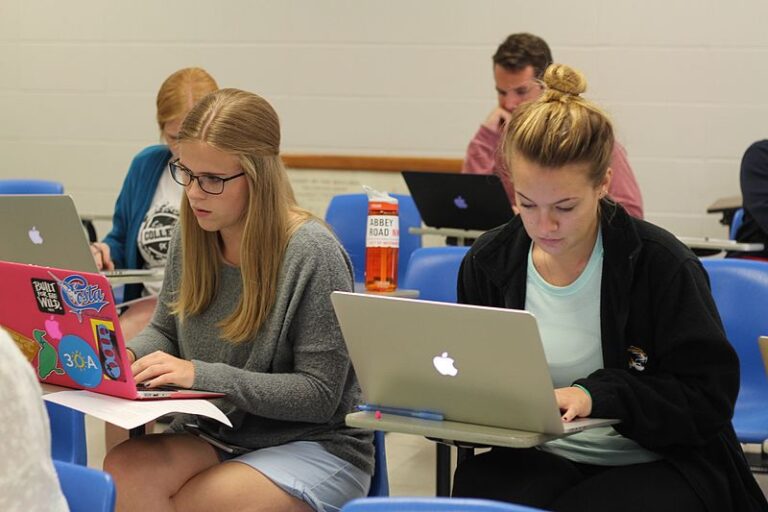The landscape of teaching and learning has dramatically transformed over the past decade. Modern classrooms differ vastly from those of yesteryears, providing a distinct experience for learners. Let’s explore the ascent of inclusive pedagogy and the tactics that lead to a holistic educational environment.
The buzz around inclusive education is increasing in educational spheres, primarily due to its myriad advantages. As this topic garners more attention, it’s crucial to understand its essence and the steps educators can undertake to incorporate it in their teaching spaces. But first, let’s lay down the foundational understanding of this approach.
Defining Inclusive Teaching
Equity-driven or inclusive teaching focuses on creating a learning space where every student, irrespective of their background, gender, ethnicity, sexual orientation, or abilities, receives equal opportunities to thrive.
Fairness, equal treatment, and respect are fundamental tenets. Educators should pinpoint and eliminate obstacles that hinder students from full participation and understanding. A crucial aspect is also for educators to introspect and eliminate any biases in their teaching approach, ensuring that the resources used are diverse and encompassing.
In sum, inclusive teaching plays a pivotal role in shaping the learning experience and the instructional design educators employ. Let’s now focus on actionable steps to embed this approach in your teaching environment.
Key Characteristics of Inclusive Pedagogy
Inclusive classrooms are at the forefront of modern education, embodying the essence of equality, understanding, and mutual respect. They are more than just a concept; they represent a shift in how we view and approach education. Some of their salient features include:
- Cultivating a sense of belonging among students: This is foundational. When every student feels they are a vital part of the classroom, it fosters mutual respect and cooperation. This sense of belonging goes beyond mere acceptance, creating an environment where students feel valued for their unique contributions.
- Establishing an inviting ambiance: The physical setup, the tone of communication, and even the use of inclusive language can make a world of difference. An atmosphere that is warm and inviting can be a catalyst for active participation and creativity.
- Ensuring psychological safety: Beyond physical safety, it’s crucial that students feel they can express themselves without fear of ridicule or embarrassment. This sense of security breeds confidence and encourages risk-taking in learning.
- Advocating for active listening: This goes both ways. Educators need to listen to their students, and students need to listen to each other. Active listening promotes understanding and empathy, fostering a more cohesive learning environment.
- Boosting student participation: In an inclusive classroom, every voice matters. Educators should employ strategies that ensure each student has an opportunity to contribute.
- Actively addressing and eliminating biases: Recognizing unconscious biases and working actively to address them creates a fairer and more just learning environment. This not only applies to educators but also encourages students to self-reflect and understand their own biases.
- Upholding and enhancing student motivation: By acknowledging and celebrating the diverse achievements of students, educators can drive motivation and inspire continued effort.
While embodying these principles demands unwavering commitment, it’s imperative to understand that the fruits of such labor are immense. These classrooms become nurturing grounds for future leaders, innovators, and compassionate citizens. The skills and values students imbibe in such environments equip them not just academically, but holistically, preparing them for the challenges and opportunities of the real world. In essence, the investment in creating inclusive classrooms yields dividends that extend far beyond the school walls.
Five Practical Steps to Foster Inclusivity
Several techniques enable educators to nurture an inclusive atmosphere for all students. Besides understanding the principles of inclusive teaching, here are some actionable strategies:
1. Prioritize a Safe Learning Ecosystem
Safety, both psychological and physical, lays the foundation for a productive learning environment. While physical safety addresses hazards and potential threats, psychological safety ensures that every student feels valued and understood. It is imperative to create an environment devoid of judgment where students can voice their concerns, mistakes, and confusions. Ground rules play a key role, setting a tone of mutual respect and understanding.
Example:
In a literature class discussing a controversial book, students should be able to voice their interpretations and feelings without the threat of backlash or mockery.
2. Diversify Educational Resources
Incorporating varied academic sources in the educational process enriches students’ perspectives, enabling them to see the world through multiple lenses. This multiplicity in resources challenges pre-existing notions, encourages critical thinking, and instills an appreciation for the vast tapestry of knowledge that exists beyond mainstream texts. Moreover, it underscores the importance of different voices and narratives, thus fostering a culture of respect and understanding.
By embracing this diversity in content, educators pave the way for students to become more globally aware, culturally sensitive, and open-minded. This approach goes beyond mere academic enrichment; it prepares students to navigate a multicultural world, making them more empathetic and informed citizens.
Example:
When discussing the concept of agriculture in a biology class, incorporating practices from various cultures, such as terrace farming in Asia or the Three Sisters cultivation method of Native Americans, offers students a panoramic view of how diverse communities harness nature. This not only enhances their knowledge base but also cultivates a deep appreciation for global traditions and innovations.
3. Address Each Student’s Unique Needs
Recognizing the individuality of each student is at the heart of inclusive education. This individuality is shaped by their cultural backgrounds, personal experiences, and specific needs, and educators should embrace this diversity rather than overlook it. By doing so, educators can craft tailored learning experiences that resonate with each student on a personal level.
The potential of personalized learning extends beyond merely accommodating students with disabilities. It’s about understanding each student’s unique learning style, pace, and interests. For instance, while some may grasp concepts quickly through visual aids, others might benefit from hands-on activities or group discussions. The goal is to make every student feel seen, heard, and understood. This not only boosts their self-confidence but also fosters a genuine love for learning.
Example:
For students with attention-deficit/hyperactivity disorder (ADHD), providing short breaks during lessons or using interactive teaching methods can keep them engaged and help in better retention of information. By adopting such tailored approaches, educators ensure that every student, regardless of their challenges, gets an equal shot at success.
4. Facilitate Active Participation
The digital transformation of education presents both opportunities and challenges. On one hand, technology has bridged geographical barriers, offering students from varied backgrounds access to quality education. On the other, it’s imperative that these platforms are designed to be inclusive and encourage active participation from all.
Incorporating inclusivity in a digital space means ensuring that tools are user-friendly, accessible to students with disabilities, and promote equitable engagement. For instance, using software that offers text-to-speech capabilities can aid students with reading challenges. Furthermore, fostering a digital environment where every student feels comfortable sharing their insights, irrespective of their backgrounds or abilities, is paramount. This goes beyond just having them contribute. It’s about creating a culture of respect where diverse opinions are celebrated and acknowledged.
Example:
In virtual group projects, assigning roles that cater to each student’s strengths can not only enhance the quality of work but also ensure that everyone feels involved and valued. By making small yet significant changes in the way digital tools are used, educators can pave the way for a more inclusive and enriching learning experience.
5. Build Genuine Connections with Students
Nurturing a deep connection between educators and students extends beyond mere academic exchanges. This bond, founded on trust, empathy, and mutual respect, enhances a student’s confidence and their willingness to engage actively in the learning process. As educators, recognizing each student’s individuality, valuing their experiences, and being sensitive to their backgrounds is crucial in building this bond.
Bias, whether explicit or implicit, can hinder the establishment of a solid student-teacher relationship. Actively working towards recognizing and challenging these biases ensures that no student feels marginalized or overlooked. Moreover, open communication plays a pivotal role in strengthening these ties. By creating spaces where students feel safe to voice their concerns, share their aspirations, and be vulnerable, educators pave the way for deeper understanding and mutual respect.
Example:
Holding periodic feedback sessions, where students can share their experiences about the teaching methods and classroom environment, can provide invaluable insights. This not only helps educators tailor their approaches but also signifies to students that their opinions are valued and considered.

The Rewards of Inclusive Pedagogy
Inclusive teaching extends numerous benefits, many of which interrelate. These include:
1. Elevating Students’ Self-Assurance
By addressing individual challenges, educators can foster confidence in students, enabling them to express themselves without apprehension. When educators customize their teaching styles to cater to different learning styles, students can easily resonate with the content. For instance, visual learners can benefit from diagrams and charts, while auditory learners might prefer lectures or discussions. By recognizing these individual challenges and providing tailored solutions, educators not only make the content accessible but also instill a sense of worth in each student. This tailored approach reinforces the idea that every student’s learning journey is valuable, resulting in heightened self-confidence and a genuine enthusiasm for learning.
2. Amplifying Participation
Creating a non-judgmental space boosts participation, with students more likely to engage willingly. Such an environment eradicates the fear of making mistakes. When students are assured that their efforts are appreciated regardless of their answers, they are more inclined to participate actively. Encouraging group activities and open discussions can further promote participation. By valuing every opinion and ensuring that no voice goes unheard, educators can foster a culture where students eagerly contribute, share ideas, and collaborate, knowing they are in a safe, judgment-free zone.
3. Augmenting Student Engagement
Engaged learners are more likely to grasp and retain knowledge. Tools and techniques to foster engagement can be pivotal. Incorporating multimedia elements, interactive sessions, or even gamifying certain aspects of the curriculum can pique students’ interests. Furthermore, linking lessons to real-world applications gives students a tangible connection, making learning more relevant. When students see the practical implications of their lessons, they are naturally more curious and engaged, leading to a deeper, more lasting understanding of the content.
4. Enhancing Comprehension Levels
By recognizing and addressing potential barriers in assessment methods, educators can significantly improve students’ understanding. Traditional testing methods might not suit every student. Offering varied assessment types – such as oral presentations, projects, or open-book exams – can accommodate different learning styles. Regular feedback sessions, where students can discuss their difficulties, can also be instrumental in enhancing comprehension. By understanding where students struggle and offering targeted support, educators can ensure that learning objectives are consistently met.
5. Refining Attitudes towards Education
Inclusivity can shift the perception of education from being a chore to a rewarding experience. When students feel respected and valued, they view education as an empowering journey rather than a tedious obligation. Celebrating small achievements, encouraging peer mentoring, and integrating real-world relevance into lessons can transform the educational landscape. These measures inspire a positive outlook, making students more receptive, enthusiastic, and motivated to learn and grow.
Championing Inclusivity and Openness
Crafting the ideal teaching space demands dedication. It’s not just about the physical environment, but also about the psychological and emotional spaces educators create for their students. A conducive learning environment recognizes the diverse needs of each student and ensures that everyone feels seen, heard, and understood. Thankfully, the evolution of technology in the educational sector has played a significant role in bridging the gap between traditional teaching methods and the diverse needs of the modern student.
One such remarkable tool is Mentimeter, which simplifies this journey by offering platforms for students to engage anonymously and confidently. In an era where students are often wary of judgment or criticism, tools like these give them the opportunity to voice their opinions, ask questions, and provide feedback without the apprehension of immediate identification. This kind of anonymous interaction can be especially beneficial in discussions on sensitive or controversial topics, where students might otherwise hesitate to participate.
Furthermore, the real-time feedback feature of Mentimeter allows educators to gauge the pulse of the classroom instantly. They can adapt their teaching methods on the fly, ensuring that the content remains relevant and engaging. The tool also supports various forms of engagement, from polls and quizzes to open-ended questions, catering to the myriad ways students prefer to communicate.
Incorporating such platforms in the classroom not only augments the teaching and learning experience but also reinforces the notion that every student’s voice matters. As educators continue to blend technology with pedagogy, they pave the way for a more inclusive, dynamic, and enriching educational journey for all.
Embracing a New Paradigm in Education
In the ever-evolving world of education, there is a pressing need to rethink traditional teaching strategies. The narrative of today’s classrooms and learning environments underscores the significance of inclusivity. The journey from understanding what inclusive teaching means, to recognizing its characteristics, and finally, implementing strategies to ensure a balanced and fair learning environment, has been enlightening. It’s worth noting that this isn’t just another teaching trend. Inclusive teaching is an approach deeply rooted in understanding human diversity, accommodating differences, and fostering a sense of belonging. It’s about ensuring every student, regardless of their background, feels seen, heard, and equally important.
The strategies outlined above are not exhaustive but offer a substantial foundation for educators looking to integrate inclusiveness into their teaching methodologies. Whether it’s diversifying the learning material, understanding the unique needs of each student, or merely providing a safe space where students can express themselves, these strategies are tools for transformation.
But beyond the strategies, it’s the ripple effect that inclusive teaching can create that holds true value. It’s not merely about enhancing a student’s academic performance, but about raising self-confidence, boosting participation and engagement, and enhancing overall comprehension. Inclusive teaching also works wonders in shaping students’ attitudes toward education, debunking the myth that learning isn’t fun or exciting. Moreover, as educators tread this path, they’ll discover countless resources and tools available to simplify the transition to a more inclusive teaching approach. It is no longer a solitary journey; collaboration tools like Mentimeter amplify the inclusivity process, ensuring that every student’s voice is valued.
In conclusion, while the road to complete inclusivity might seem challenging, the outcomes are undeniably rewarding. Not just for the students, but also for the educators who witness the transformative power of a genuinely inclusive learning environment. Embracing inclusivity isn’t just an educational strategy; it’s a paradigm shift towards a brighter, more equal future in education.


















+ There are no comments
Add yours